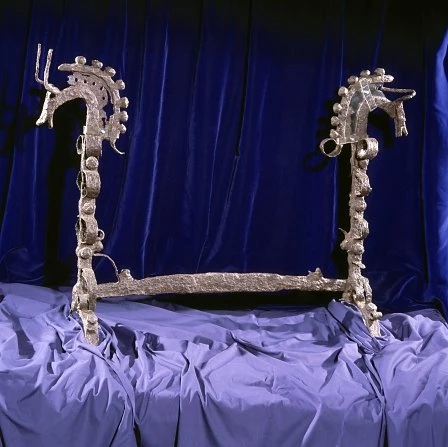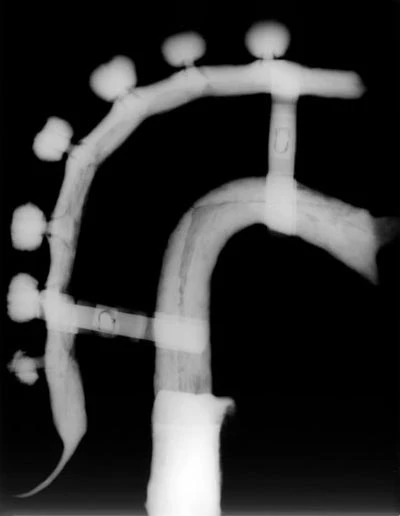Stunning ironwork firedog uncovered in farmer’s field
The Capel Garmon Firedog (Conwy). Firedogs are decorated stands used to contain wood burning in a fireplace. This fine example has heads and crests shaped to resemble aspects of both a bull and a horse.
Detail showing one of the heads on the firedog. The head may have represented a mythical creature recounted in the tales of warriors or an emblem of the tribe or community of its owners.
X-ray of one of the heads on the Capel Garmon Firedog. This X-ray shows the complex way in which the firedog was constructed. (The horizontal and vertical struts are modern supports added to stabilize the head).
Experimental iron smelting has shown the amount of time and skill that would have been involved in the production of the Capel Garmon Firedog.
This iron stand with two opposing horned animal heads is known as the Capel Garmon Firedog, and was made by a master craftsperson of the Celtic Iron Age.
An offering to the gods
Found in 1852, the firedog was uncovered in a field at Carreg Goedog Farm, Capel Garmon (Conwy). It lay on its side, with a large stone placed at each end, and was deeply buried. Its careful placing and unbroken state suggest that it was deliberately placed as an offering to a god of the pagan Celtic world. This fits into a long-established tradition of depositing metalwork in Wales’s lakes, rivers and bogs during the Bronze and Iron Ages.
One of a pair
Originally one of a pair, the firedog would have sat next to a hearth at the centre of a timber or stone round-house. This hearth would have been a natural focus for eating, feasting and discussion and the firedog would have been on view to be admired by all.
Recent X-raying of the firedog, together with an attempt to replicate the artefact by a modern blacksmith, has shown that its maker was a master craftsperson, highly skilled in shaping and working iron.
Magical process
It has been estimated that the Capel Garmon Firedog may have taken one person over 3 years to make, from the gathering of raw materials, through the smelting of the ore to the finishing of the artefact. This transformation of iron ore into metal was probably viewed as a magical process by the Celts, and blacksmiths would have been given great respect for the powers that they wielded.
Dating the Capel Garmon Firedog is difficult - there were no archaeologists to record the excavation. However, since the Capel Garmon find, similar firedogs have been discovered in south-east England, in the graves of Iron Age chieftains.
In addition to the firedogs, these burials were accompanied by grave goods, all of which can be dated to between 50BC and AD75 - the Late Iron Age. It therefore seems likely that the Capel Garmon firedog was also buried around this time.
Iron was first used in Wales at around 750BC. From 300BC onwards iron tools, weapons and brooches became increasingly common on hillforts, settlements and in hoards. However, the scale and quality of the Capel Garmon Firedog sets it apart from these objects. Despite all the discoveries that have been made in the past 150 years, it remains one of the most important pieces of early decorative ironwork to have been found in Britain.
Background Reading
Celtic art, reading the messages by M. Green. Published by Weidenfeld & Nicholson (1996).
'Firedogs in Iron Age Britain and beyond' by S. Piggott. In The European community in later prehistory: studies in honour of C. F. C. Hawkes by J. Boardman, M. A. Brown and T. G. E. Powell, p245-70. Published by Routledge & Kegan Paul (1971).
'The Capel Garmon Firedog' by C. Fox. In The Antiquaries Journal, vol. 19, p446-8 (1939).




Comments - (4)
Hi Luke,
Thank you for your enquiry. I can confirm that the ironwork firedog is currently on display in the Gweithdy gallery at St Fagans National Museum of History. However, be aware that the gallery will be closed from Monday 6 until Thursday 9 January. Details on opening times can be found on our St Fagans webpages.
Many thanks,
Nia
(Digital Team)
I'm sorry to inform you that the firedog isn't on display at the moment, as our historical collections are in the process of moving to St Fagans National Museum of History. I've passed your comment on to our Archaeology curators, to see if we can arrange for you and your mother to view the firedog in storage.
Best wishes,
Marc
Digital Team